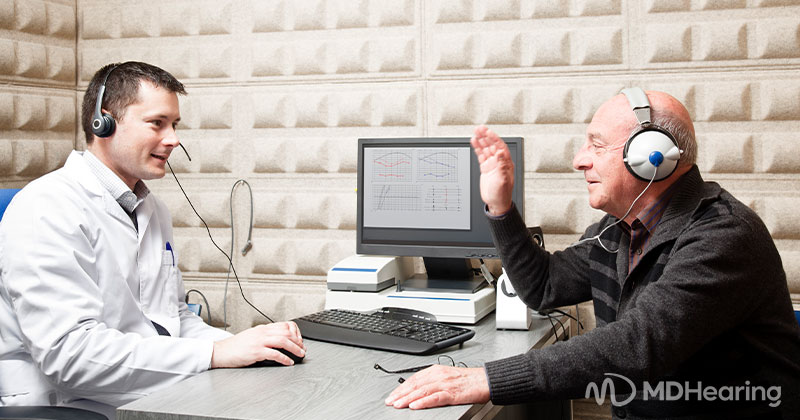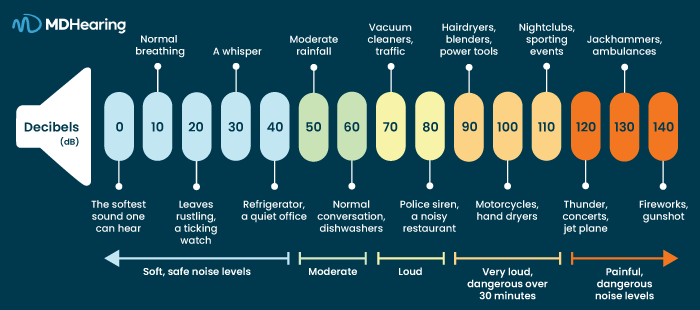Have you been wondering how much hearing loss you need to have before requiring a hearing aid?
There are five levels of hearing loss. The degree of hearing loss is determined by the ability to hear certain frequencies (Hz) at each level of hearing loss, which is measured in decibels (dB). A decibel chart shows the intensity levels of environmental sounds you commonly hear around the house, at work, in school, and in other places. These different sounds range from 0 dB (the average sound a person can hear with normal hearing) to 140 dB (the threshold of pain).
It can be a bit tricky to know when you need hearing aids because hearing loss varies from person to person. While some people have sudden hearing loss, the majority of people lose their hearing gradually over time. In fact, you might have any of the various types of hearing loss and not even realize it. However, a basic understanding of the different levels of hearing loss will help you determine if you need hearing aids.
Do you suspect that you or a loved one has some hearing loss? Take our free online hearing test to determine your level of hearing. It's easy to do from the comfort of your home, and you'll get immediate results!
Mild Hearing Loss (25–40 dB)
If the quietest sounds you can hear fall between 25 and 40 dB, then you have mild hearing loss. At this level, you can still have normal conversations, but you’ll have trouble hearing certain sounds, such as soft whispers, children’s voices, and the ticking of a watch. Many people at this level don’t realize they have hearing loss unless they’ve taken a hearing test. Even still, you may benefit from wearing hearing aids to ensure you're not missing out on certain sounds and to prevent further loss.
Sounds you may not be able to hear with mild hearing loss:
-
10 dB – Normal breathing
-
20 dB – Leaves rustling, a ticking watch
-
30 dB – Whispers
Moderate Hearing Loss (41–55 dB)
If you have moderate hearing loss, you won’t be able to pick up sounds that fall in the 41 to 55 decibel range. It’s at this level that you might start having trouble understanding what a person is saying, especially if they talk softly. You may also notice that you're not hearing common everyday sounds like you used to. For this reason, people are more likely to consider hearing aids at the moderate hearing loss level. In addition, this is the level at which you may get the most benefit from hearing aids.
Sounds you may not be able to hear with moderate hearing loss:
-
40 dB – Refrigerator hum, a quiet office
-
40-60 dB – Normal conversation
Moderately-Severe Hearing Loss (56–70 dB)
At the moderately-severe level of hearing loss, you'll likely have much more difficulty talking to people, whether or not they're soft-spoken, and even more so in noisy environments. The greater the level of hearing loss, the less likely your ears are able to pick up certain consonant and vowel sounds that are important parts of understanding speech. As such, a hearing aid at this level is vital.
Sounds you may not be able to hear with moderately-severe hearing loss:
-
50 dB – Moderate rainfall
-
60 dB – Conversations, dishwashers
Severe Hearing Loss (70–90 dB)
At the severe hearing loss level, you'll find there are many everyday sounds you can't hear that otherwise would be considered loud. Additionally, having conversations with people, whether they're soft-spoken or not, will be a challenge. If you have this much hearing loss, you definitely could benefit from wearing hearing aids. However, as the severity of hearing increases, the ability of hearing aids to help you hear better often decreases.
Sounds you may not be able to hear with severe hearing loss:
-
70 dB – Vacuum cleaners, traffic, washing machine
-
80 dB – A noisy restaurant, police car siren
Profound Hearing Loss (90 dB and higher)
If you have profound hearing loss, you're probably accustomed to turning your TV or radio up very high. Unfortunately, most electronic devices stop at a maximum volume of about 100–110 dB. As such, you may find that no matter how high you turn the sound up, you still can't hear well. You'll also have extreme difficulty participating in conversations, talking on the phone, and understanding speech in large auditoriums. Chances are you rely on reading lips and may not even realize it.
Someone with profound hearing loss may only be able to hear very loud sounds. At this level, wearing hearing aids can help some people to a degree but may require more advanced treatment like surgery or a cochlear implant.
Sounds you may not be able to hear with profound hearing loss:
- 90 dB – Hairdryers, blenders, power tools, lawnmower
-
100 dB – Motorcycles, hand dryers
-
110 dB – Nightclubs, sporting events, shouting in the ear
-
120 dB – Thunder, concerts, a jet plane taking off
-
130 dB – Jackhammers, ambulances
-
140 dB – Fireworks, gunshot
Find Out If You Can Benefit From Hearing Aids
Have you been told you always ask others to repeat themselves? Or perhaps your family complains that you have the volume of the TV turned up too loud. Knowing all about the different levels of hearing loss is necessary to best understand your hearing health. After all, it's not always that obvious you have a hearing issue to begin with, particularly at the lower level of hearing loss and if your hearing gradually worsens over time. No matter the case, you might benefit from hearing aids.
Hearing aids come in a wide range of different shapes, sizes, and features. Learn all about in-ear hearing aids and behind-the-ear (BTE) hearing aids to find out which type might be better suited for you.
At MDHearing, we want to ensure everyone has a chance to hear better and improve their quality of life. We offer our own line of FDA-registered medical devices, and they're available at very affordable prices. That's because we cut out the middleman, passing the savings right to you. Compare our hearing aids today—every device comes with a free 45-day trial and risk-free guarantee.
Take our free online hearing test to find out if you fall within any level of hearing loss.
TAKE ONLINE HEARING TEST

